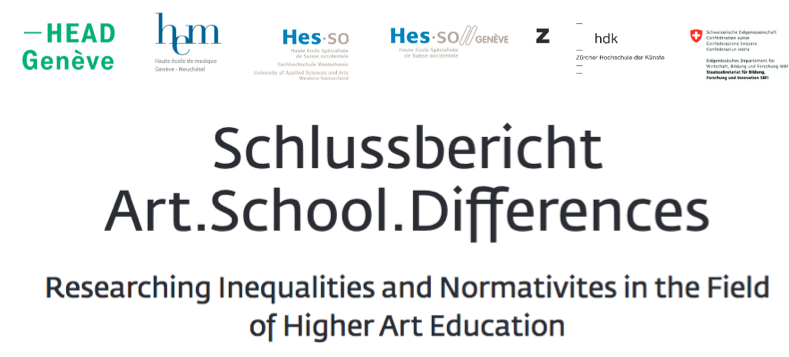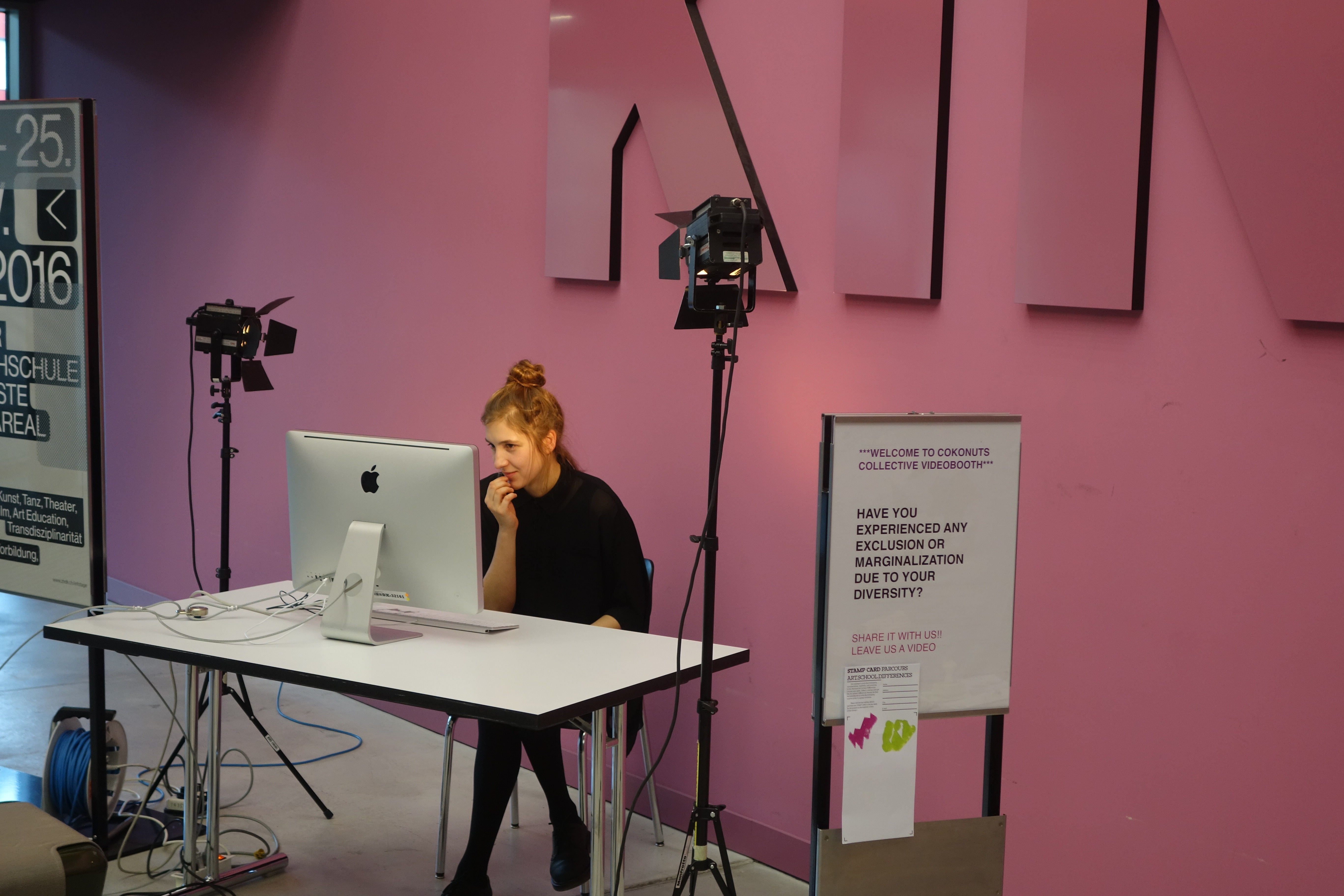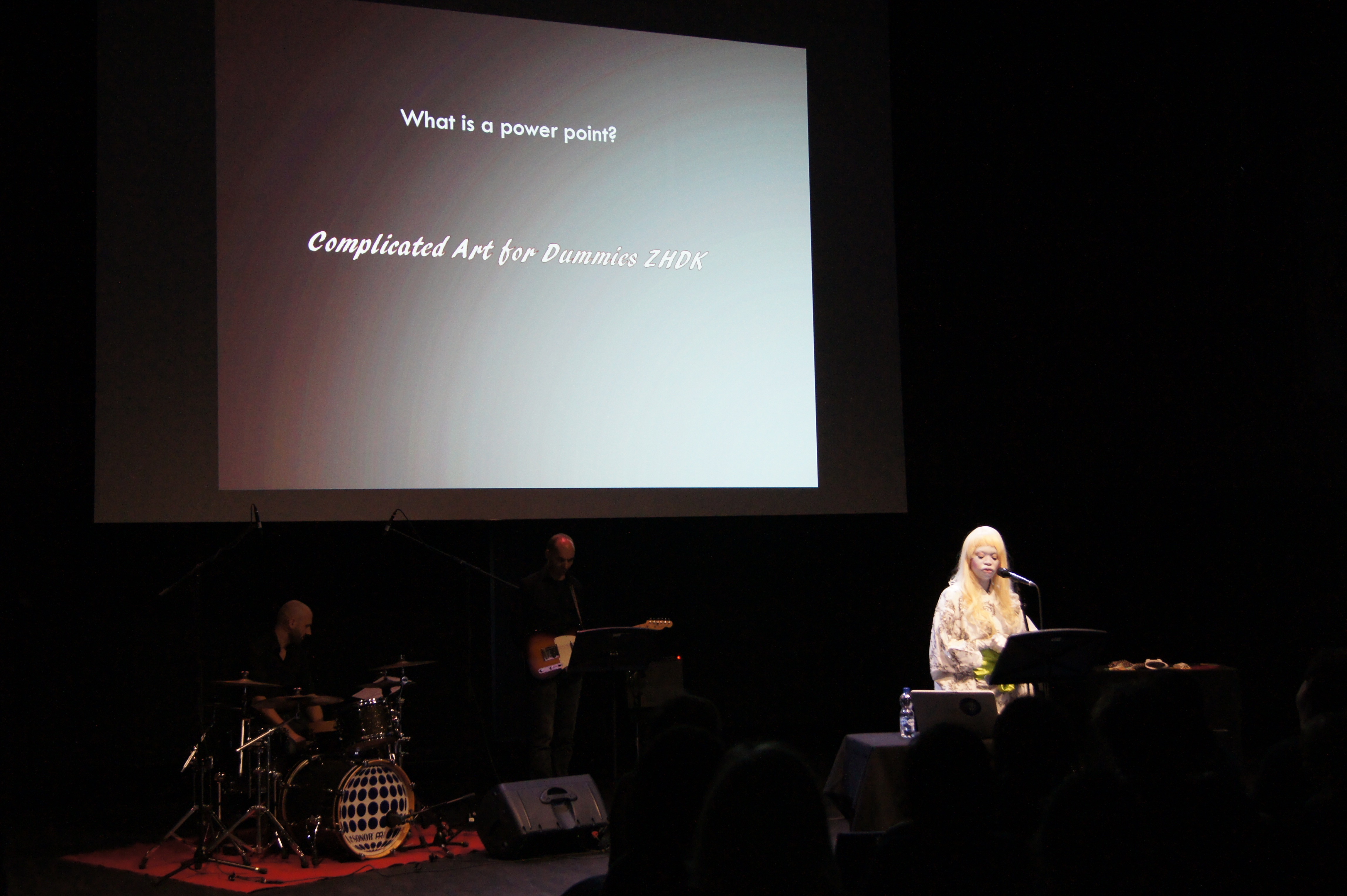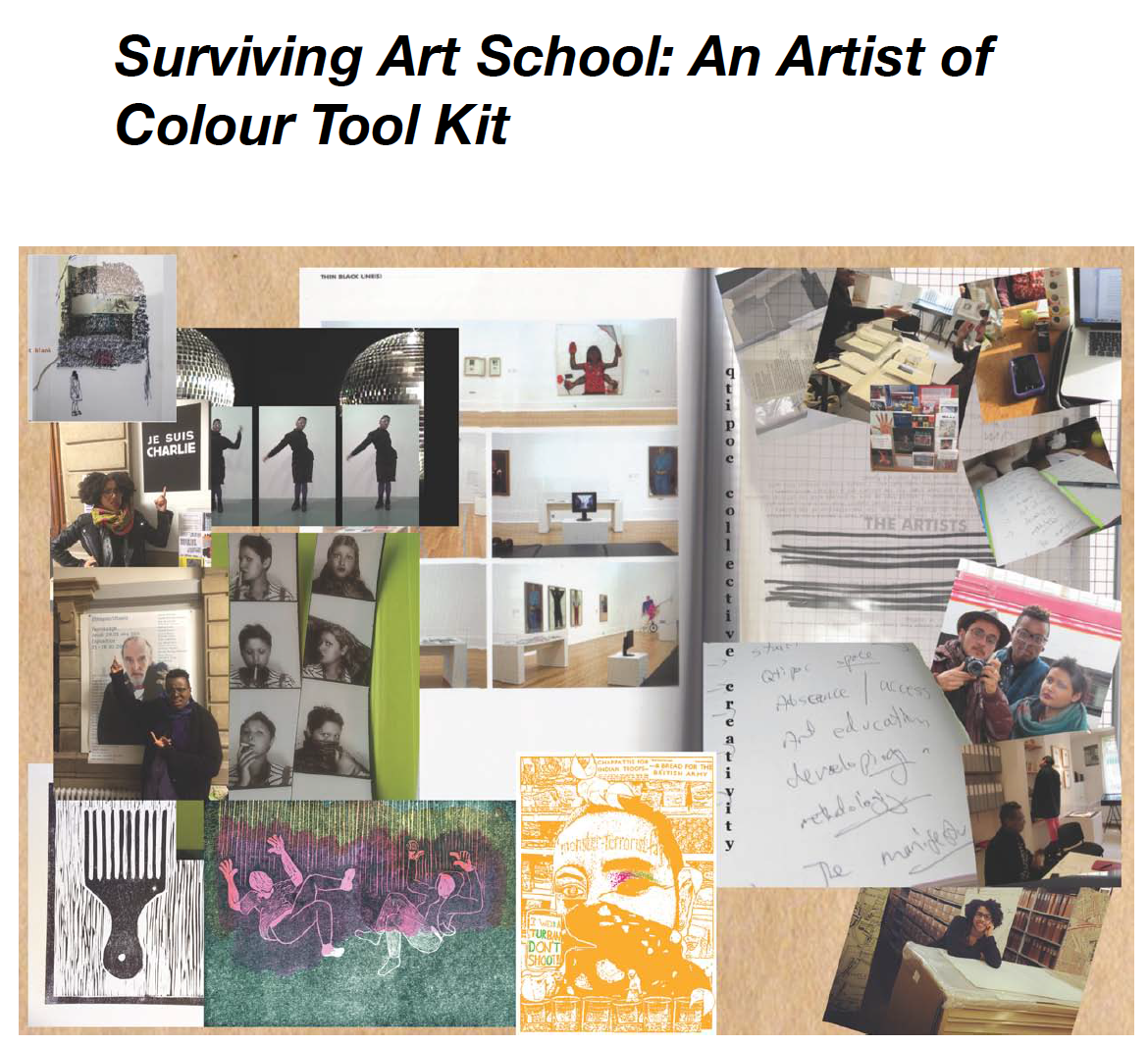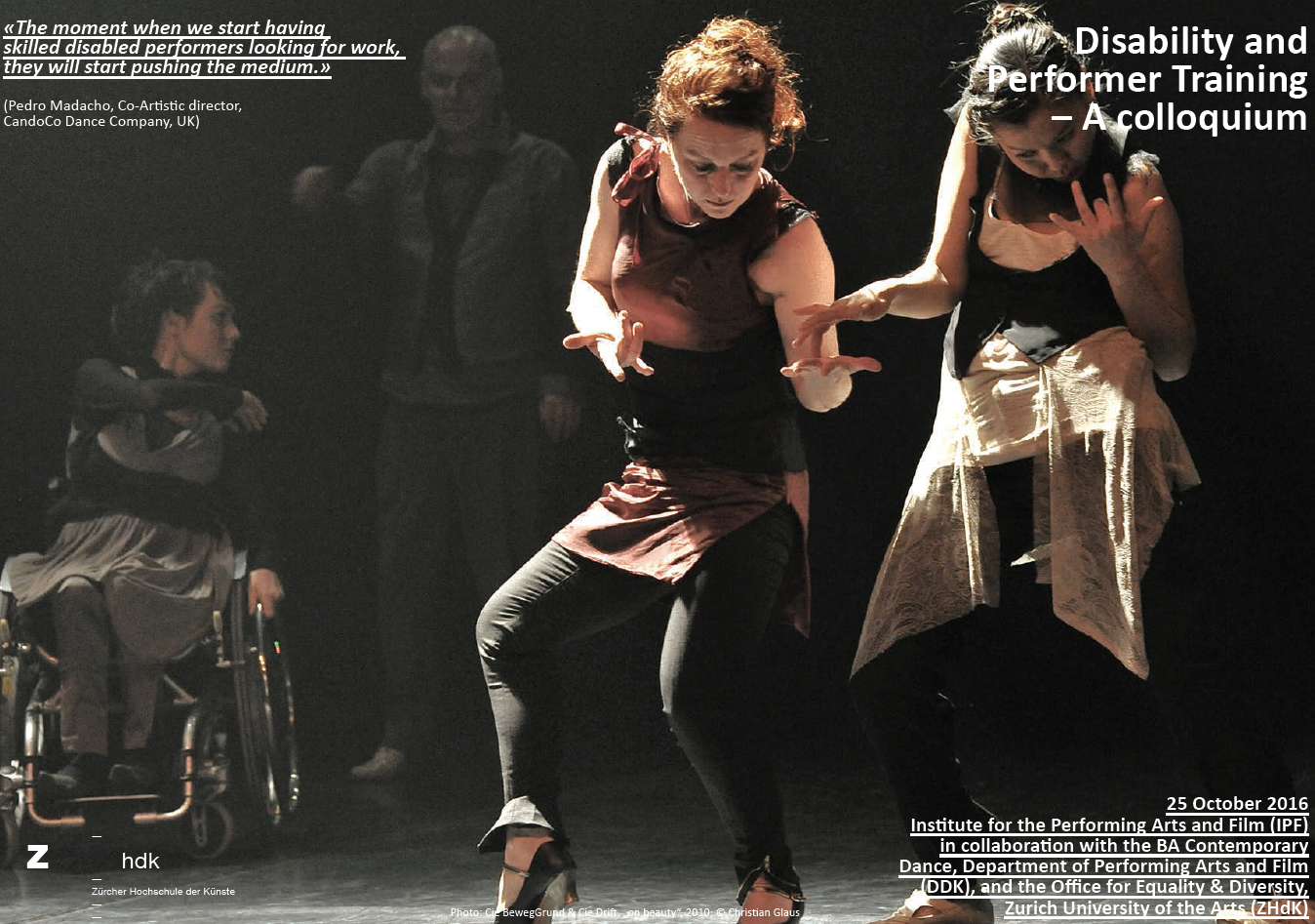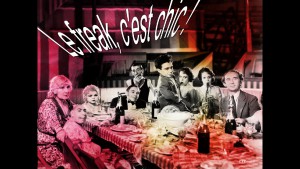Le rapport final Art.School.Differences, les prises de positions des écoles partenaires et la meta-prise de position à leur sujet du comité scientifique international sont en ligne sous rapport final et prises de position.
Le chapitre 9 synthétise les conclusions, chapitre 10 rassemble les champs d’action identifées pour parvenir à une école d’art plus inclusive.
Author: sophievoegele
Disability inclusion
REPORT ON THE FINAL ART.SCHOOL.DIFFERENCES SYMPOSIUM by Nina Mühlemann*
I attended the Symposium ‘Because it’s 2016! Challenging inclusion and exclusion at Swiss art schools’ as someone with a strong interest both in the performing arts and in disability inclusion. Growing up as a wheelchair user in Zurich and studying English and German literature in Basel, a critical analysis of disability or its representation was never part of the curriculum alongside gender, race or sexuality, even though I longed for theoretical frameworks that included disability. Once I discovered Disability Studies and realised that this was an emerging field in the UK and the USA, I decided to pursue a Master’s degree in the UK. Currently I am writing my doctoral thesis at King’s College London about the vibrancy of disability arts in the UK. When I arrived to do my master’s degree in London in 2010, I was amazed and delighted to discover the high professional standard of disabled artists in the UK in all art fields. Often, this work gives profound insight into different ways of being in the world and how we, as a society, value them.
I was very curious to hear at the Symposium what the situation is like in Switzerland for young disabled people who are keen to become professional artists. Where do Swiss art schools stand at the moment when it comes to inclusion? What are the barriers, and how can they be removed? What kind of insight can experts give who have been working in the field or art school inclusions all over the world? What can we learn from their experiences? This report will be written from a perspective that focuses on how disability was addressed during the Symposium, and I will attempt to insert disability into some of the questions or issues that were raised during those two days.
The day at ZHdK started off with Sophie Vögele, Philippe Saner, Pauline Vessely and Carmen Mörsch presenting their research on social differences in the admission process at Swiss art schools. The participating schools were the Zurich University of the Arts (ZHdK), the Haute école d’art et de design – Genève (HEAD – Genève) and the Haute école de musique Genève – Neuchâtel (HEM).
The researchers took a report from the UK as a starting point, Jackie McManus’ study ‘Art for a Few’, which stated that art schools are for the privileged, people who are white and middle-class. The researchers were then interested to find out how art schools in Switzerland recruit, evaluate and select their candidates – what is the ‘ideal student’ in this process, and furthermore, how do students cope with the idea of this ‘ideal student’? Are there any mechanisms that effect the exclusion of very specific social groups? In their results, they found, for example, that more and more students of artistic disciplines have at least one parent with a university degree and come from culturally privileged families.
When it came to presenting fields of tensions within the selection process at art schools, the group stated that the criteria this process is based on is often very vague, which in theory could open up a space for the unexpected, for students who are ‘other’ – yet, this was not what the researchers found, on the contrary, a normative identity seems to remain a requirement.
When it comes to disability, in particular, one finding was difficult to swallow: During the open days at ZHdK for the degrees in theatre and dance, it has been stated very openly by the art school that a normative physicality and mental wellbeing is a requirement for admission. This requirement is stated publicly, which perhaps shows that discrimination of disabled people is still something that happens very openly in Switzerland. In other parts of the assessment it is also made clear that it is a requirement to be in full physical and mental health to be able to do this degree. Why is this still acceptable? The title of the evening was after all ‘Because it’s 2016!’, and that such open discrimination in 2016 is still possible made me feel furious. It also made me feel extremely grateful that this research project and the rigorous work of the researchers was there to uncover this discrimination, put it on the table and offer it up for discussion.
Many of the rigorous requirements in traditional arts training are tied to able-bodiedness – Can students practice day and night? Can they mould their bodies for their artform in a way that makes their identity disappear? Can they adapt themselves and their artwork to whatever ideal their teachers or the market demands from them? All forms of perceived difference that deviate from a fabricated normative ideal are seen automatically as lesser, as not good enough.
Not demanding compulsory able-bodiedness from students would mean to let them mould the artform so that it suits their bodies and competences, not the other way around. As disabled artists in the US and in the UK have shown repeatedly, opening up art forms – dance, theatre, visual arts, performance – to disabled bodies can enrich these art forms and release new creative possibilities. This does not mean that whole curricula have to be changed, but it does demand a more flexible approach towards assessing students’ competences and a willingness to imagine a potential that goes beyond the already familiar from teachers and admission officers. It requires a willingness of teachers to be taught by their students sometimes, too.
The researchers then gave us a little preview of the reader, which will be available from early 2017. It was created based on the findings of their research, and texts in English, German and French. The reader will have five volumes and one of them focuses on disability inclusion. The reader was created as a tool and resource for teaching, but also as a support for negotiations that happen within the sector of higher education.
After this first insight, we heard the first two keynotes, which were both fantastic. First on was Rubén Gaztambide-Fernández, with a talk entitled ‘Creation, Participation, and the Political Life of Cultural Production’. It centred around the idea of cultural production, and how it can be used. Within this rhetoric, artistic forms are understood as processes, taking material conditions, cultural contexts and social circumstances into account. What cultural production is currently granted the status of ‘the arts’? Gaztambide-Fernández explored how particular conditions are needed to achieve this status, and he wondered whether it was possible for us, as a society, to relocate or resignify what we mean by the arts and to destabilise the hierarchy that often structures what is seen as arts and what is not.
Gaztambide-Fernández explained that traditionally, but also in a neoliberal context specifically, the arts are often framed as a substance or medicine that can be injected and has transformative qualities, as a tool to civilise citizens and especially young people. As a result, what we understand as ‘the arts’ becomes trapped by its own rhetoric, being seen as something that maintains ‘European civilization’, or in other words, European cultural supremacy.
Although Gaztambide-Fernández did not mention this, the injection of arts as ‘medicine’ is highly visible within a disability context where art is often seen as a form of rehabilitation or therapy. While art of course can be therapeutic, in these contexts the produced art is often seen as of little value, simply because it was produced as a means of therapy.
The second keynote was by Nana Adusei-Poku, entitled ‘Everyone Has to Learn Everything!’. She was talking about her own experience as a researcher and teacher within higher education at Rotterdam University of Applied Science. She explained that while the general population of Rotterdam consists of 55% people of colour and 45% white people, she does not see this population reflected in her class rooms. Adusei-Poku introduced me to the concept of racial time with the example that up until some decades ago, books were first given to white schools and then handed down to black schools. This delay produced a knowledge gap. Currently, there is another knowledge gap produced by racial time at schools, as the core curriculum is always based on white history, while black history is deemed ‘elective’ and absent in the canon. Adusei-Poku sees her work as decolonising work and acknowledged that this work is uncomfortable as it is destabilizing hierarchies, and as such is often met with resistance.
Adusei-Poku further talked about her experience of caring for her white students as a black educator and the emotional labour that comes from discussing whiteness with white people. This kind of emotional work that educators take on themselves is extremely necessary and, at the same time, under-appreciated and devalued.
While Adusei-Poku voiced some frustrations about her role, as most often she can only reach those who are already willing to listen, her talk also showed how important it is for inclusion not only to happen on a student level, but also on a staff level, in order to provide an inclusive and stimulating environment to all students. To see some of the work Adusei-Poku has done and what she has achieved together with her students and allies was extremely inspiring and left me feeling very positive.
What followed after these two wonderful keynotes was somewhat disheartening and also a clear example of the resistance Adusei-Poku mentioned that her work towards inclusion is often met with.
It was now time for three directorate-members of the art schools participating in the study to respond to the findings of the report. Hartmut Wickert of ZHdK, Lysianne Léchot Hirt of HEAD – Genève and Xavier Bouvier of HEM Genève-Neuchatel started the discussion on a defiant note, with Bouvier stating that everything he was going to say would get deconstructed anyway as he was seen as ‘the voice of power’. Wickert expressed that he found the fields of action identified in the report disappointing and unsatisfying, as the school had to adhere to strict frameworks already given and that enacting change would be difficult. Léchot Hirt was prepared to claim more responsibility for the findings of the study in her answer, saying that results came as a shock to her as the institution considers itself as innovative, and the study proved a rigidity and a predictability of the institution that she did not realize was there.
In their responses, all three educators repeatedly brought up the marketplace and the standard the market expects from absolvents of art schools, suggesting implicitly that the market demands certain kinds of people, especially ones that are already privileged. Some statements also made it seem as if rigid policies implemented on a cantonal and national level made it next to impossible for the schools themselves to evoke change. The three educators also questioned the methodology of the study, which seemed to serve as a distraction to respond to the real issues the report had pointed out. As the discussion progressed it became clear that many in the audience, myself included, were dismayed by the reaction of the gatekeepers of these three institutions.
I appreciate the gatekeeper’s presence at the discussion, because this is not something that can be taken for granted, and it shows a readiness to listen. Léchot Hirt also stayed for most of the 2-day symposium, which shows a willingness to learn about the issues discussed and openness for change. I am also aware that there well may be instances where a lack of funding or rigidly imposed frameworks make it difficult for the schools to enact change. However, as I mentioned at the beginning of the post, when it comes to disability there has been the case of such discouragement towards disabled students that has come from the ZHdK itself that I know there are profound misunderstandings and shortcomings which need to be addressed urgently.
In the discussion Wickert brought up DisAbility on Stage as an example where a step towards inclusion had already been taken, a research project at ZHdK which “aims to foster a discourse on dis/ability within Swiss Art Schools and universities by questioning models of dis/ability in theoretical reflection, performing practice and education. It brings together a unique team with members from national universities, art schools, dance and theater companies, and festivals, by including the three major Swiss language regions.” I am very excited about this project, but also dubious whether it is enough to readdress the systematic exclusions of disabled performers that have been happening for decades at Swiss art schools. DisAbility on Stage aims to bring disabled artists and art students together to foster understanding and collaboration, but it does not change the fact that disabled students are discouraged to apply to ZHdK.
I voiced this concern in the discussion and was told that the curricula of the art programmes at ZHdK could not be changed overnight and yet again that the art schools depend on applicants who the market has a demand for. Several people furiously spoke out against this response – as someone pointed out, justifying your exclusions and ableism with the fact that the same thing is happening on ‘the market’ is not good enough, especially as other countries such as the UK have shown that a) including disabled students does not require a complete change of the curricula and b) there is a market for disabled artists.
Once the discussion round was over I felt angry and disappointed, but also hopeful and, once again grateful for the people who did this research and organized this symposium to address the inequalities their research brought to light. A very energetic performance by Ntando Cele finished the day on a quite provocative note – Ntando slipped into different roles and the show encompassed a monologue chock-full of dark humour and punk songs performed live on stage, all the while addressing the systemic racism present in the art world, but also in Switzerland generally.
This full-on day left me quite exhausted for the 9am start on Saturday, but the two keynotes were once again fascinating: Cornelia Bartsch talked about the gendered and queer spaces she found in the music of Bach, and the music included in her presentation felt wonderfully soothing after the highly emotional experiences on the day before. Rena Onat and Bahareh Sharifi discussed the current situation in Germany, where a recent political decision to let refugees into the country was accompanied with funding of cultural education for those refugees, even though a further art school education is most of the time not a possibility for them. Furthermore, they brought in examples of artists in Germany and elsewhere who have experienced racism and used these experiences to think through structures of support.
After the two keynotes, there was a parcours where different rooms invited us to engage further with some of the questions and issues raised in the keynotes and presentations. While I enjoyed the two rooms I visited, I really needed the time to properly digest all the input from the two days, and more importantly, to connect with other people who attended the symposium. This was one of the most gratifying insights from the symposium: It opened up a room where alliances could be voiced and built. Fields that work with identity can sometimes be a little inward looking. In disability studies, we sometimes think about disability without taking other markers of difference or intersectionality into account when in reality, it can be so productive to look outwards, to share our insights and to listen to the insights of others.
In the afternoon, Melissa Steyn gave the final keynote about the important decolonizing work she has done within education in South Africa, and then Adusei-Poku, Jackie McManus, Olivier Moeschler, Ruth Sonderegger, Melissa Steyn and Ulf Wuggenig in their capacities as International Advisory Board members did a conference wrap-up. They highlighted again how important this work of the report is, and that the resistance that was shown towards it showed how necessary it was to get the ball rolling. I was very glad that I attended the symposium, even if it was upsetting for me to be confronted with the findings of the report. I left the symposium on a hopeful note, feeling inspired about all the fascinating research I heard about, especially as I think it will have an impact on the way I approach the classrooms I am teaching in. I am very excited for the readers to be published and hope that this research has been an important milestone which will evoke change at Swiss art schools and beyond.
*Nina Mühlemann is a doctoral student and Teaching Assistant at King’s College London at the Department for English Literature. Her focus is to analyse works of disabled artists and compare them to mainstream representations of disability. The title of her thesis is ‘Beyond the Superhuman: Performing Disability Arts Around London 2012’.
I’M HERE AND I’M BLACK, BUT I’M NOT HERE TO BE BLACK
ART.SCHOOL.DIFFERENCES: REPORT ON THE FINAL SYMPOSIUM by Quentin Delval*
Arriving at the Toni Areal after a long day and a longish train ride, I wasn’t in top form when I entered the Hörsaal 1 around 7:15pm. But the setting instantly refreshed me. Attendees were engaged in an intense discussion. “So you’re basically saying you can’t improve living conditions of minority students because that’s not what the market wants, even though you’re part of what creates that market?” was an attendee asking, the microphone in her hands. An art school representative sitting on stage had just explained to the audience that schools depend on what the “market” wants, in terms of student output. “The reality is that we depend on that”, he said, “so it is a bit more complex than just changing curriculum and practices”. He wouldn’t get away with such a “chicken and egg” contradictory stance. I heard someone whisper “so we don’t end colonialist thinking because it expects us not to?”. I raised an eyebrow. Art.School.Differences, you had my attention.
The conversation revolving around how to circumvent institutional inertia (“of course we need to change things, and of course we can’t wait until society’s ready, but we need to do it the smart way”, i.e. not now, not radically) was brought to a halt by the categorical imperative of the clock. But it was only to give us time to attend the next part of the evening, a performance that would show exactly why Art is a necessary part of thinking and changing (minds about) inequalities. Half part prejudice-triggering show, half part Fanon-based concert, the performance was a real chance for one to burst their little own racist bubble. Emphasizing that “I’m here and I’m black, but I’m not here to be black”, the artist also reminded us that “black people can write (books) too” and we should read them. How many books have you read, this year, that have been written by black authors?
Refreshed by the scent of smart, radical questioning emanating from this first evening, I went to sleep with a feeling of impatience for the next day.
TRANSFORMING THE GAZE
It wasn’t just out of personal need for academic brainstorming and entertainment that I appreciated this start of the week-end. One of the main challenges of equality in Universities of Applied Sciences in Switzerland today lies in the need to make contact with and convince the ones who need to be. Transforming the gaze of the people operating at key positions of the power structures. Extend the talk beyond the inner circle of the people already working in the field of equal opportunity and/or social justice. How do you convince people who, most of the time, won’t even hear the words you have to say, won’t share your definitions, perceptions of reality, and immediate interests? The second day of Art.School.Differences’ final symposium would provide ample choice of answers.
The keynotes, to start with, highlighted what certainly are major aspects of how domination is maintained, namely the illusion that it comes from a rhetoric construction one would just have to debunk in order to see equality advance, and the illusion that theoria is how you rebalance the access to the power structures of society. The focus of the talks therefore opened room for a materialist understanding of domination (in Delphy’s sense) coupled with the need of praxis spaces: the sexist and racist theories and distribution of power are the symptom of a power structure that also has to be addressed by granting access to a praxis, a collective experience, interaction, even at a local level, which empowers the individuals with more than words, and potentially changes the minds.
DECENTRALIZE YOUR ASS
And coherently enough, this is what the parcours was all about. Five hours of workshops, interactive performances, questioning discussions – and walking around the building, here getting a glimpse of ballet dancers practicing, there being caught by the red sound of a trumpet – all served the purpose of bringing your senses to your attention. Inequality is not (only) staged in the conscious mind, it is performed by all senses, by all forms of attention, and they all need their time of deconstruction and reconstruction. “What is this?” asks a performer, holding coffee beans in her hands, standing in a dark room in which selective lighting directs your attention, “what is this?”. Someone says “coffee beans” and she reacts “really? Really?”. It is true that we could have said “the direct consequence of a collusion between colonialist structures of power and neoliberal economy” (ah, are those different?), which are also alive in the other items on that table, chocolate, tea, bananas…. It is true we should decentralize our perspective if we were to understand the fabric of the worlds, both objective and subjective. It is true that what we have to decentralize is not only our minds, granting us with the comfortable feeling of having “understood” exclusion or privilege, but it is our very ass that needs to move aside. It is true we have a responsibility in giving birth to the freedom of our perception. That we have to remove our mask and stop expecting others to put one on.
Maybe it is my background in philosophy (or, as one workshop organizer emphasized, aren’t backgrounds rather foregrounds? I had spent the week reading about students with “Migrationshintergund” and that remark hit the right spot), but I found these phenomenological experiences quite on point. They were asking us to think with more than the theoretical bits we had acquired through the years, they were actually asking what thinking really was about. In another workshop, art-related feminist practices were “offered” to the attendees. One could listen to a video by Judith Butler and/or draw and/or look around the room for feminist manifestos and/or take interest in national statistics on gender inequality and/or do nothing. Which was a good revelator of our relative incapacity to seize our curiosity and be an active part of our “decentralization” – most of us were just expecting to be told about this passage from talk to action. But it was ours to build.
HOLDING POWER STRUCTURES ACCOUNTABLE
Another very important part of the symposium had to do with discussing the institutional obstacles to social justice in art schools: often through a clever mobilization of bourdieusian sociology, attendees were invited to reflect upon the conditions of possibility of failure and success in an art school – which, of course, bears important similarities with the rest of the educational landscape. What kind of capital(s) do you need to get in? And once you’re in, how is the institution allowing you to adapt to its contradictory, ambiguous demands of normalization? How do you become this original artist (teacher standard) who still has to evolve in a school standardized to fit the global market (institution standard)? How do you reconcile being asked to develop your own style, your individuality, when diversity is not allowed structurally? How do you deal with being judged solely on your own individual work within one individual class, while at the same time being supposed to be ready for a job market in which you’ll be requested to work in groups on different disciplinary tasks at the same time? How can you succeed when the teachers’ set of skills does not include diversity training, and they confuse your working-class critical perspective on mass-produced aesthetics with a lack of (established) taste? How do you survive never being sure of where you are and why?
The symposium also offered great opportunities to deal with those realities (and I am intentionally not using the word “questions” here), providing some tools to start creating our own synthesis. Art schools can try to “fix the women” and “fix the minorities” by injecting them with skills, resources, networks and access to the established competition. But that won’t serve any other purpose than perpetuating the inherently flawed social logic of the said competition. Art schools have to fix themselves, and have to be held accountable for their involvement in the solidification of discriminating power structures.
This mirrors the priorities of higher education at large today. Whether it is about horizontal (access to the training) or vertical (progression in the structures of power) discrimination, words are not enough, and it is not the minorities who solely “need help”. Educational institutions need to help themselves, educate themselves too. Open praxis spaces, decentralize their perceptions, think of how they can rebuild those on critical grounds, and implement changes – at least those were, among others, leads discussed over the week-end.
And maybe this can start with a simple question, which was also generously given to us in the conclusion to the symposium: to whom do the schools belong? To whom do the schools belong?
*Quentin Delval is working with the development services of Human Resources and diversity at the French University of applied science HES-SO. The team he works with is responsible to coordinate actions for the equality and diversity – and to intitate new ideas – within all the schools affiliated to the structures of Universities of Applied Sciences in the French speaking part of Switzerland (Romandie). In his doctoral thesis in philosophy at the Uiversité de Louvain-la-Neuve in Belgium he wrote about how scientific expertise ultimately generates the exclusion of the groups it claimed to represent or protect.
Surviving Art School. An Artist of Colour Tool Kit
We would like to draw your attention to a publication Surviving Art School. An Artist of Colour Tool Kit created by Collective Creativity, which came out of a workshop and lecture at Nottingham Contemporary; discussing race and politics in art schools today. It is accessible via this link.
A further publication key words devised by artist Evan Ifekoye and produced in collaboration with Schools and Teachers Tate London Learning is available via this link.
About Collective Creativity: Collective Creativitiy is an intentional informal non-hierachical collective space created to share ideas to reflect on texts/films/art (and more) in a group setting, that inspire, interest or provoke us and/or our practice. Collective Creativity is a group formed out of necessity, to carve collaborative space outside of the institutional framework where a specific Black QTIPOC (queer/trans* people of colour) voice and experience could be nurtured. Collective Creativity are Evan Ifekoya, Raisa Kabir, Rudy Loewe and Raju Rage. For more information please refer to their website.
Disability and Performer Training – a colloquium, Tuesday 25th of october
“The moment when we start having skilled disabled performers lokking for work, they will start pushing the medium.” (Pedro Madacho, Co-Artistic director, CandoCo Dance Company, UK)
With a critical comment provided by Art.School.Differences in the plenary afternoon-discussion. Flyer
Save the date, November 11./12.2016: Challenging Exclusion 2016!
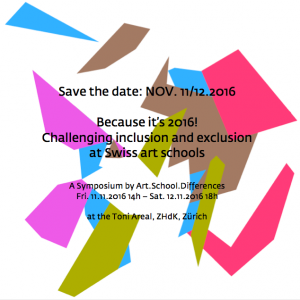 SAVE THE DATE: November 11/12.2016 at the Toni Areal, ZHdK, Zürich
SAVE THE DATE: November 11/12.2016 at the Toni Areal, ZHdK, Zürich
Join us for a final symposium by Art.School.Differences
→ Find out about the main findings of the research
→ Listen to keynotes by Nana Adusei-Poku (Rotterdam), Cornelia Bartsch (Hamburg), Rubén Gaztambide-Fernàndez (Toronto), Bahareh Sharifi with Rena Onat (Berlin), and Melissa Steyn (Johannesburg)
→ Support us for the book launch of the Art.School.Differences Reader
→ Attend a panel with the deans of the participating schools (HEAD – Genève, HEM – Genève, ZHdK)
→ Enjoy a performance by Ntando Cele (Bern)
PLAY and WIN in an anti-discriminatory parcours to engage with
→ The daily micro-practices of discrimination of international students at art schools.
→ The notion of good design and its role in design education: “Are you ‘good’ enough?”
→ Reflections on decolonizing the curricula at art schools: Everyone has to learn everything.
→ Making Differences through solfège.
→ Double-quoted world: how designers with working class background deconstruct universal categories of aesthetics.
→ Mentoring and practices of collective supervision.
→ Challenging power structures in the arts – «the master’s tools will never dismantle the master’s house» (Audre Lorde).
→ Vage Vorstellung vom eigenen Ausdruck in Kunst und Unterricht.
→ Art related Feminist practices: How to deviate from normativities? Artists at work, from talk to actions.
→ Perceptions of the student’s curriculum at a design school: Resistance, assimilation, dissimulation, confrontation and autonomy.
With: Nana Adusei-Poku, Patricio André, Lorenz Bachofner, Claire Bonnet, Marie-Antoinette Chiarenza, Victor Cordero, Maëlle Cornut, Fabio Fernandes Da Cruz, Laura Ferrara, NIC Kay, Julia Kuster, Paola de Martin, Andrea Nucamendi, Sarah Owens, Romy Rüegger, Nora Schiedt, Micha Seidenberg, Daniel Zea, and others
The conference language will be mainly English with some parcours contributions in German and French.
Conference convenors: Carmen Mörsch, Sophie Vögele, Dora Borer, Philippe Saner with Maja Renn.
For inquiries please contact: Sophie Vögele (sophie.voegele@zhdk.ch)
Invite to colloquium 5: Disability, ableism and the body: Diversifying, the politics of representation and queering art school
Friday, 3rd of July 2015
18.00h
Xavier Bouvier, Haute École de Musique (HEM)
Welcoming and introductory remarks
18.15h – 19.45h
Sébastien Kessler: Le freak, c’est chic
In his talk, Sébastien Kessler – “survivor of eugenics” or “opportunistic slacker” – embraces his visible impairment as an asset rather than a disability. What is our perspective on a population that at times is stigmatized as being vulnerable, while at other times is judged as impressive? How do you balance the conflicting and yet most normal desires to be both ordinary and extraordinary? Come listen to Sébastien and participate in a debate on the art of being freak in our contemporary society. — Freak out!
[dis]abled, Sébastien Kessler is physicist and health economist, an alderman in Lausanne’s City Council, community activist and founder of a consulting firm that specializes in universal access to the built and outdoor environments and services (www.id-geo.ch)
Venue: Haute École d’Art et de Design, HEAD, Auditoire, Boulevard James Fazy, 15, Geneva.
